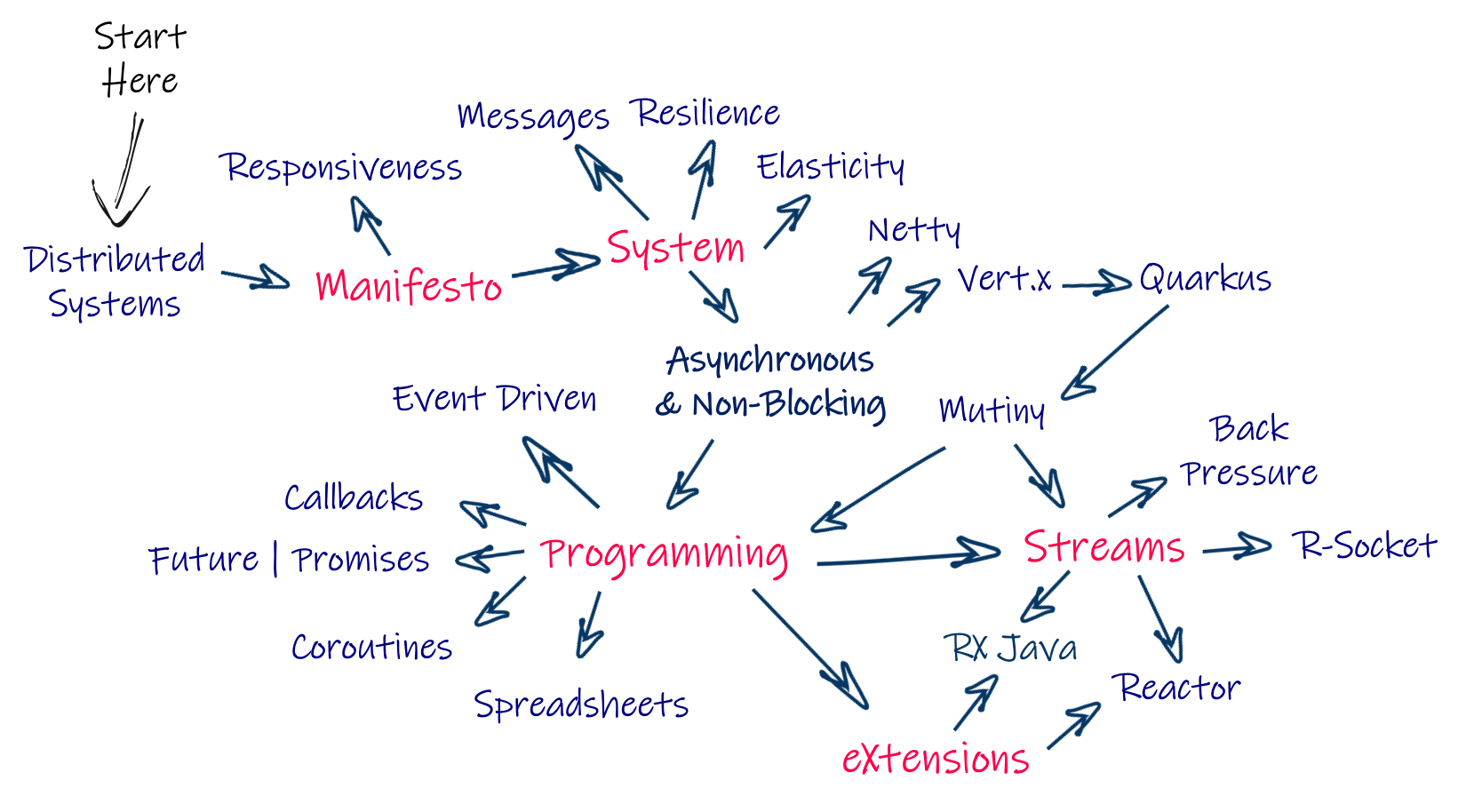Please use JDK 11 to run all demos.
- Java 9 Flow
- RxJava 1.x
- RxJava 2.x
- Reactor 3.2.x
- RSocket
- Reactive API for Cache, Messaging
- Reactive with HTTP: webclient & retrofit
- Kotlin
- Webflux
- Kotlin Coroutines & Flow
- Reaktive: Kotlin multi-platform implementation of Reactive Extensions
- reactive: 响应的,响应式的
- streaming: 流式的
- asynchronous: 异步的
- non-blocking: 非阻塞的
- Observable 可观测的
- Single: 单个的
- Flux: 流量
- Mono: 单一的
- Creation
- Combine
- transform(map,flatMap)
- Filter
- Mathematical and Aggregate Operators
- Utility Operators
- Conditional and Boolean Operators
- Error Handling
- Publisher: A Publisher is a provider of a potentially unbounded number of sequenced elements, publishing them according to the demand received from its Subscriber(s).
- Subscriber: Receive call to onSubscribe(Subscription) once after passing an instance of Subscriber to Publisher.subscribe(Subscriber).
- Subscription: A Subscription represents a one-to-one lifecycle of a Subscriber subscribing to a Publisher, use subscription.request() method to request items.
- Processor: Processor represents a processing stage—which is both a Subscriber and a Publisher and obeys the contracts of both
- Observable
- Operators
- Single
- Subject
- Scheduler
https://www.baeldung.com/java-9-reactive-streams
- java.util.concurrent.Flow: Interrelated interfaces and static methods for establishing flow-controlled components
- SubmissionPublisher: publisher
- Observable: This class provides methods for subscribing to the Observable as well as delegate methods to the various Observers.
- Single: Reactive Pattern for a single value response
- Observer: Provides a mechanism for receiving push-based notifications
- Subscriber: Provides a mechanism for receiving push-based notifications from Observables, and permits manual unsubscribing from these Observables.
RxJava 2 features several base classes you can discover operators on:
- io.reactivex.Flowable: 0..N flows, supporting Reactive-Streams and backpressure
- io.reactivex.Observable: 0..N flows, no backpressure,
- io.reactivex.Single: a flow of exactly 1 item or an error,
- io.reactivex.Completable: a flow without items but only a completion or error signal,
- io.reactivex.Maybe: a flow with no items, exactly one item or an error.
- Notification: Represents the reactive signal types: onNext, onError and onComplete and holds their parameter values (a value, a Throwable, nothing)
- Subject: Represents an Observer and an Observable at the same time, allowing multicasting events from a single source to multiple child Observers
- Flux: A Reactive Streams {@link Publisher} with rx operators that emits 0 to N elements, and then completes (successfully or with an error).
- Mono: A Reactive Streams {@link Publisher} with basic rx operators that completes successfully by emitting an element, or with an error.
- FluxSink: next/error/complete sink to push data to flux
- FluxProcessor: processor
- Signal: A domain representation of a Reactive Stream signal. There are 4 distinct signals and their possible sequence is defined as such: onError | (onSubscribe onNext* (onError | onComplete)?)
Stream process: Source -> Flow -> Sink
- Source: A processing stage with exactly one output, emitting data elements whenever downstream processing stages are ready to receive them.
- Sink: A processing stage with exactly one input, requesting and accepting data elements possibly slowing down the upstream producer of elements
- Flow: A processing stage which has exactly one input and output, which connects its up- and downstreams by transforming the data elements flowing through it.
- Source.single: Stream a single object
Operators: https://doc.akka.io/docs/akka/2.5/stream/operators/index.html#source-operators
https://kafka.apache.org/documentation/streams/
- Topology: A topology is an acyclic graph of sources, processors, and sinks.
- KafkaStreams: A Kafka client that allows for performing continuous computation on input coming from one or more input topics and sends output to zero, one, or more output topics.
- KStream: an abstraction of a record stream of eyValue pairs
https://projectreactor.io/docs/kafka/release/reference/
- KafkaSender: publishing messages to Kafka
- KafkaReceiver: consuming messages from Kafka
- RxJava诞生早,使用广泛,尤其在Netflix产品中
- Reactor和Spring整合密切
- 在Java 8支持方面,Reactor基于Java 8,而RxJava是自己的API
- RxJava的模型在其他语言都有实现,如果你用多语言的场景化,RxJava的模型更好一些,如Angular等
https://www.nurkiewicz.com/2019/02/rxjava-vs-reactor.html
BlockHound(block代码猎犬)是一个Java agent,主要检测非阻塞线程中的同步调用。 我们常见的同步方法如下:
- java.lang.Thread: sleep, yield, onSpinWait
- java.lang.Object: wait
- java.io.RandomAccessFile: read0, readBytes, write0, writeBytes
- java.io.FileInputStream: read0, readBytes
- java.io.FileOutputStream: write, writeBytes
- java.net.Socket: connect
- java.net.DatagramSocket: connect
- java.net.PlainDatagramSocketImpl: connect0, peekData, send
- java.net.PlainSocketImpl: socketAccept
- java.net.SocketInputStream: socketRead0
- java.net.SocketOutputStream: socketWrite0
- sun.misc.Unsafe: park
- jdk.internal.misc.Unsafe: park
- java.lang.ProcessImpl: forkAndExec
- java.lang.UNIXProcess: forkAndExec
凡是涉及到以上代码,都是同步调用,需要注意,尤其是使用wait和notifyAll来设计线程协调。
- java.util.concurrent.CountDownLatch: await
Reactor for handling error: doOnError, onErrorMap, onErrorReturn, and onErrorResume
- doOnError: executed when an error is thrown and hasn't been caught
- onErrorMap: used to map an error into another error. As it's only being mapped, the error is still thrown
- onErrorReturn: set a fallback value that will be returned if error is thrown. The next operator in the chain will get the fallback value instead of error.
- onErrorResume: set a fallback method that will be executed if error is thrown. The next operator in the chain will get the result of the fallback method instead of error.
- http://www.reactive-streams.org: Reactive Streams is an initiative to provide a standard for asynchronous stream processing with non-blocking back pressure
- http://reactivex.io: An API for asynchronous programming with observable streams
- http://projectreactor.io: Reactor is a second-generation Reactive library for building non-blocking applications on the JVM based on the Reactive Streams Specification
- https://tech.io/playgrounds/929/reactive-programming-with-reactor-3/content/Intro
- http://reactivex.io/documentation/operators.html: reactive operations
- https://dzone.com/articles/functional-amp-reactive-spring-along-with-netflix: Functional and Reactive Spring with Reactor and Netflix OSS
- RxJava2 响应式编程介绍: https://zouzhberk.github.io/rxjava-study/
- Reactive Streams: https://github.com/reactive-streams/reactive-streams-jvm/blob/v1.0.2/README.md#specification
- RSocket: http://rsocket.io/
- Reactor Netty: http://projectreactor.io/docs/netty/release/reference/index.html
- Reactor Testing: http://projectreactor.io/docs/core/release/reference/index.html
- RxJava Extensions: https://github.com/akarnokd
- Reaktive — a multiplatform library for reactive Kotlin: https://github.com/badoo/Reaktive https://badootech.badoo.com/reaktive-a-multiplatform-library-for-reactive-kotlin-android-ios-77b6ff25adb1
- Reactive Spring Boot: https://learning.oreilly.com/live-training/courses/reactive-spring-boot/0636920371410/
- Reactive marble diagram generator: https://bitbucket.org/achary/rx-marbles/ https://medium.com/@jshvarts/read-marble-diagrams-like-a-pro-3d72934d3ef5
- Animated playground for Rx Observables: https://rxviz.com/
- SmallRye Mutiny: a reactive programming library https://github.com/smallrye/smallrye-mutiny
